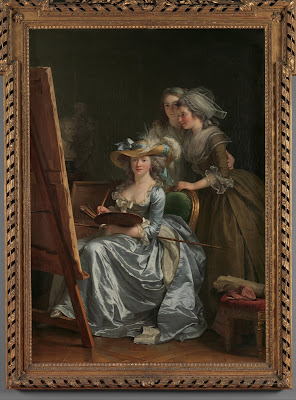Artist Profile: Adélaïde Labille-Guiard
Adélaïde Labille-Guiard was born on April 11, 1749, to a fairly wealthy family. Her father, Claude-Edme Labille, was a shopkeeper in Paris, France. As the youngest of eight, little is known about her childhood. She was married at the age of twenty to Louis Guiard, but separated in 1777 so she could pursue her art career.
She started painting miniature works with pastels. To gain admission to the French Royal Academy she had to submit an oil painting. She enlisted the help of François-Élie Vincent, a portrait painter. He became a mentor of hers, and through him she met his son François-André Vincent. François-André and Adélaïde became good friends. After his father's death, François-André became one of her mentors and companions.
On May 31, 1783 Adélaïde and Élisabeth Louise Vigée-LeBrun became the 12th and 13th women ever granted full membership in the French Royal Academy. Only four women at a time could study at the Academy. The additions of Adélaïde and Élisabeth brought the Academy to its limit. She was lauded for her skilled portraits using oils and was a respected member of the Academy by her early twenties. She was awarded the title of Peintre des Mesdames, meaning she painted portraits of the King's aunts. Due to her gender and beliefs, she was often the target of vicious gossip from her male peers. Some concluded her work was the product of an affair with François-André. She responded saying, "One must expect to have ones talent ripped apart, who can plead on behalf of women's morals?"
While studying at the Royal Academy, Adélaïde became a mentor to other women. Her most famous painting is "Self-Portrait with Two Pupils", which featured her prized student Marie Capet. It was a bold statement at the time, but was wildly popular when displayed at the Salon.
It was a tumultuous time for France. Unlike many of her colleagues, Adélaïde supported the French Revolution although she was in a dangerous position, and stayed in Paris. In 1793, King Louis XVI was executed. Later that same year, his wife Marie Antoinette was also executed. The Louvre was opened in 1793 and opened to the public in 1801.
The Revolution did bring positive change to Adélaïde's life. She used the marriage reforms to divorce her husband, Louis Guiard, and later married rumored lover François-André Vincent in 1799. She was granted a state pension and lived the rest of her life painting and teaching at her apartment in Louvre. She died on April 24, 1803.
At the time, Elisabeth Vigee-Le Brun was more popular and her paintings were considered better than Labille-Guiard’s. Now, art historians believe their art is equivalent, some believing Adélaïde’s is better. Adélaïde's paintings are considered stylistically Rococo to Neoclassicist. Other famous works include:





Comments
Post a Comment